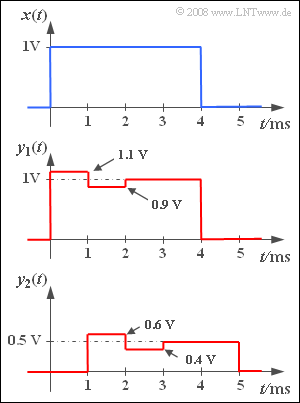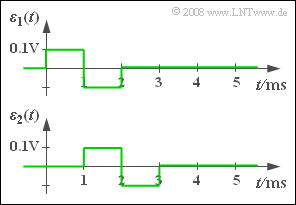Difference between revisions of "Aufgaben:Exercise 2.2: Distortion Power"
| Line 22: | Line 22: | ||
| − | + | In general, the so-called signal–to–distortion–power ratio is given by the following formula | |
:$$\rho_{\rm V} = \frac{ \alpha^2 \cdot P_{x}}{P_{\rm V}} \hspace{0.05cm}.$$ | :$$\rho_{\rm V} = \frac{ \alpha^2 \cdot P_{x}}{P_{\rm V}} \hspace{0.05cm}.$$ | ||
| − | + | Here, | |
| − | *$P_x$ | + | *$P_x$ denotes the power of the signal $x(t)$, and |
| − | *$\alpha^2 \cdot P_x$ | + | *$\alpha^2 \cdot P_x$ denotes the power of $y(t) = \alpha \cdot x(t - \tau)$, that would arise as aresult in the absence of distortion. |
| − | + | Usually, – as also in this task– this S/N-ratio $\rho_{\rm V}$ is given logarithmically in $\rm dB$ . | |
| Line 53: | Line 53: | ||
| − | { | + | {Compute the signal–to–distortion–power ratio for system $S_1$. |
|type="{}"} | |type="{}"} | ||
$10 \cdot {\rm lg} \ \rho_\text{V1} \ = \ $ { 23.01 3% } $\ \rm dB$ | $10 \cdot {\rm lg} \ \rho_\text{V1} \ = \ $ { 23.01 3% } $\ \rm dB$ | ||
| − | { | + | {What parameters $\alpha$ and $\tau$ should be used to calculate the distortion power of the system $S_2$ ? <br>Justify your result. |
|type="{}"} | |type="{}"} | ||
$\alpha \ = \ $ { 0.5 3% } | $\alpha \ = \ $ { 0.5 3% } | ||
| Line 64: | Line 64: | ||
| − | { | + | {Determine the distortion power of the system $S_2$. |
|type="{}"} | |type="{}"} | ||
$P_{\rm V2} \ = \ $ { 5 3% } $\ \cdot 10^{-3} \ {\rm V}^2$ | $P_{\rm V2} \ = \ $ { 5 3% } $\ \cdot 10^{-3} \ {\rm V}^2$ | ||
| − | { | + | {Compute the signal–to–distortion–power ratio for the system $S_2$. <br>Interpret the different results. |
|type="{}"} | |type="{}"} | ||
$10 \cdot {\rm lg} \ \rho_\text{V2} \ = \ $ { 16.99 3% } $\ \rm dB$ | $10 \cdot {\rm lg} \ \rho_\text{V2} \ = \ $ { 16.99 3% } $\ \rm dB$ | ||
| Line 79: | Line 79: | ||
===Solution=== | ===Solution=== | ||
{{ML-Kopf}} | {{ML-Kopf}} | ||
| − | [[File:P_ID915__LZI_A_2_2_a.png|right|frame| | + | [[File:P_ID915__LZI_A_2_2_a.png|right|frame|Resulting error signals]] |
| − | '''(1)''' | + | '''(1)''' The error signal $\varepsilon_1(t)$ shown in the graph is obtained with the given parameters $\alpha = 1$ and $\tau= 0$ . The distortion power is thus equal to: |
:$$P_{\rm V1} = \frac{ {1 \, \rm ms}}{4 \, \rm ms} \cdot \big[ ({0.1 \, \rm V})^2 + | :$$P_{\rm V1} = \frac{ {1 \, \rm ms}}{4 \, \rm ms} \cdot \big[ ({0.1 \, \rm V})^2 + | ||
({-0.1 \, \rm V})^2\big]\hspace{0.3cm}\Rightarrow \hspace{0.3cm}P_{\rm V1} \hspace{0.15cm}\underline{ = 5 \cdot 10^{-3} \, \rm V^2}. $$ | ({-0.1 \, \rm V})^2\big]\hspace{0.3cm}\Rightarrow \hspace{0.3cm}P_{\rm V1} \hspace{0.15cm}\underline{ = 5 \cdot 10^{-3} \, \rm V^2}. $$ | ||
Revision as of 05:49, 11 September 2021
A rectangular pulse $x(t)$ with amplitude $1 \hspace{0.08cm} \rm V$ and duration $4 \hspace{0.08cm} \rm ms$ is applied to the input of a communication system. Then, the pulse $y_1(t)$ , whose signal parameters can be taken from the middle sketch, is measured at the system output.
At the output of another system $S_2$ , the signal $y_2(t)$ shown in the lower sketch is obtained with the same input signal $x(t)$ .
Let the following definition apply to the error signal used in this task:
- $$\varepsilon(t) = y(t) - \alpha \cdot x(t - \tau) .$$
The parameters $\alpha$ and $\tau$ are to be determined such that the distortion power (the mean squared error) is minimal. For this, the following holds:
- $$P_{\rm V} = \overline{\varepsilon^2(t)} = \frac{1}{T_{\rm M}} \cdot \int\limits_{ ( T_{\rm M})} {\varepsilon^2(t) }\hspace{0.1cm}{\rm d}t$$
These definitions already take into account that a frequency-independent damping just as a runtime which is constant for all frequencies does not contribute to the distortion.
The integration interval has to be chosen appropriately in each case:
- Use the interval $0$ ... $4 \hspace{0.08cm} \rm ms$ for $y_1(t)$ and the interval $1 \hspace{0.08cm} {\rm ms}$ ... $5 \hspace{0.08cm} \rm ms$ for $y_2(t)$ .
- Thus, the measurement time is $T_{\rm M} = 4 \hspace{0.08cm} \rm ms$ in both cases.
- It is obvious that with respect to $y_1(t)$ die Parameter $\alpha = 1$ and $\tau = 0$ respectively result in the minimum distortion power.
In general, the so-called signal–to–distortion–power ratio is given by the following formula
- $$\rho_{\rm V} = \frac{ \alpha^2 \cdot P_{x}}{P_{\rm V}} \hspace{0.05cm}.$$
Here,
- $P_x$ denotes the power of the signal $x(t)$, and
- $\alpha^2 \cdot P_x$ denotes the power of $y(t) = \alpha \cdot x(t - \tau)$, that would arise as aresult in the absence of distortion.
Usually, – as also in this task– this S/N-ratio $\rho_{\rm V}$ is given logarithmically in $\rm dB$ .
Please note:
- The exercise belongs to the chapter Classification of the Distortions.
- In particular, consider the pages
Questions
Solution
(1) The error signal $\varepsilon_1(t)$ shown in the graph is obtained with the given parameters $\alpha = 1$ and $\tau= 0$ . The distortion power is thus equal to:
- $$P_{\rm V1} = \frac{ {1 \, \rm ms}}{4 \, \rm ms} \cdot \big[ ({0.1 \, \rm V})^2 + ({-0.1 \, \rm V})^2\big]\hspace{0.3cm}\Rightarrow \hspace{0.3cm}P_{\rm V1} \hspace{0.15cm}\underline{ = 5 \cdot 10^{-3} \, \rm V^2}. $$
(2) Die Leistung des Eingangssignals beträgt:
- $$P_{x} = \frac{1}{4 \, \rm ms} \cdot ({1 \, \rm V})^2 \cdot {4 \, \rm ms}\hspace{0.15cm}{ = {1 \, \rm V^2}}.$$
- Mit dem Ergebnis aus (1) erhält man somit für das Signal–zu–Verzerrungs–Leistungsverhältnis:
$$\rho_{\rm V1} = \frac{ P_{x}}{P_{\rm V1}}= \frac{ {1 \, \rm V^2}}{0.005 \, \rm V^2}\hspace{0.05cm}\rm = 200\hspace{0.3cm} \Rightarrow \hspace{0.3cm} 10 \cdot {\rm lg}\hspace{0.1cm}\rho_{\rm V1}\hspace{0.15cm}\underline{ = {23.01 \, \rm dB}}.$$
(3) Die Skizze auf dem Angabenblatt macht deutlich, dass sich auch ohne die auftretenden Verzerrungen – sondern allein durch Dämpfung und Laufzeit das Signal $y(t)$ von $x(t)$ – deutlich unterscheiden würde.
- Es würde sich $y(t) = 0.5 \cdot x(t-1\ {\rm ms}) $ ergeben.
- Wenn jemand diese Werte nicht sofort aus der Grafik erkennt, so müsste er für sehr (unendlich) viele $\alpha$– und $\tau$–Werte zunächst das Fehlersignal
- $$\varepsilon_2(t) = y_2(t) - \alpha \cdot x(t - \tau)$$
- und anschließend den mittleren quadratischen Fehler ermitteln, wobei das Integrationsintervall jeweils an $\tau$ anzupassen ist.
- Auch dann würde man das kleinstmögliche Ergebnis für $\alpha \; \underline{= 0.5}$ und $\tau \; \underline{= 1 \ \rm ms}$ erhalten. Für diese Optimierung von $\alpha$ und $\tau$ sollte man sich allerdings schon ein Computerprogramm gönnen.
(4) Die obige Skizze zeigt, dass $\varepsilon_2(t)$ bis auf eine Verschiebung um $1 \ \rm ms$ gleich dem Fehlersignal $\varepsilon_1(t)$ ist. Mit dem Integrationsintervall $1 \ {\rm ms}$ ... $5 \ {\rm ms}$ ergibt sich somit auch die gleiche Verzerrungsleistung:
- $$P_{\rm V2} = P_{\rm V1} \hspace{0.15cm}\underline{ = 5 \cdot 10^{-3} \, \rm V^2}.$$
(5) Entsprechend dem Angabenblatt gilt:
- $$\rho_{\rm V2} = \frac{ \alpha^2 \cdot P_{x}}{P_{\rm V2}}= \frac{ 0.5^2 \cdot {1 \, \rm V^2}}{0.005 \, \rm V^2}\hspace{0.05cm}\rm = 50\hspace{0.3cm} \Rightarrow \hspace{0.3cm} 10 \cdot {\rm lg}\hspace{0.1cm}\rho_{\rm V2} \hspace{0.15cm}\underline{= {16.99 \, \rm dB}}.$$
- Trotz gleicher Verzerrungsleistung ist $10 \cdot {\rm lg}\hspace{0.1cm}\rho_{\rm V2}$ gegenüber $10 \cdot {\rm lg}\hspace{0.1cm}\rho_{\rm V1}$ um etwa $6 \ \rm dB$ geringer.
- Das Signal $y_2(t)$ ist also hinsichtlich des SNR deutlich ungünstiger als $y_1(t)$.
- Es ist berücksichtigt, dass nun wegen $\alpha = 0.5$ die Leistung des Ausgangssignals nur noch ein Viertel der Eingangsleistung beträgt.
- Würde man diese Dämpfung am Ausgang durch eine Verstärkung um $1/\alpha$ kompensieren, so würde zwar die Verzerrungsleistung um $\alpha^2$ größer.
- Das Signal-zu-Verzerrungs-Leistungsverhältnis $\rho_{\rm V2}$ bliebe jedoch erhalten, weil auch das "Nutzsignal" um den gleichen Betrag angehoben wird.

